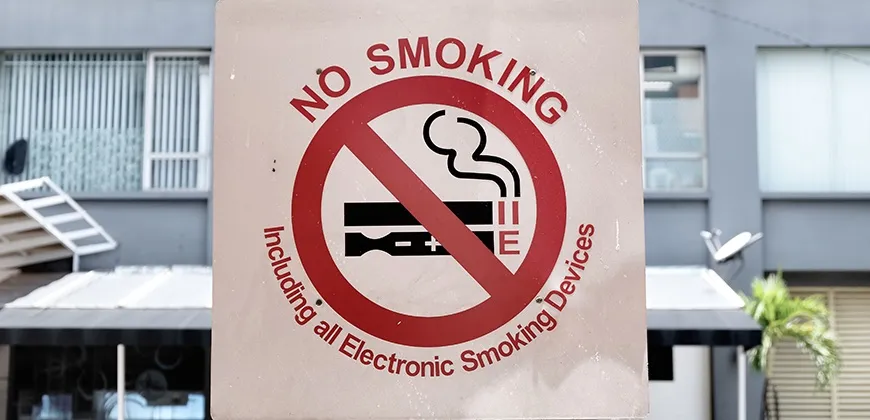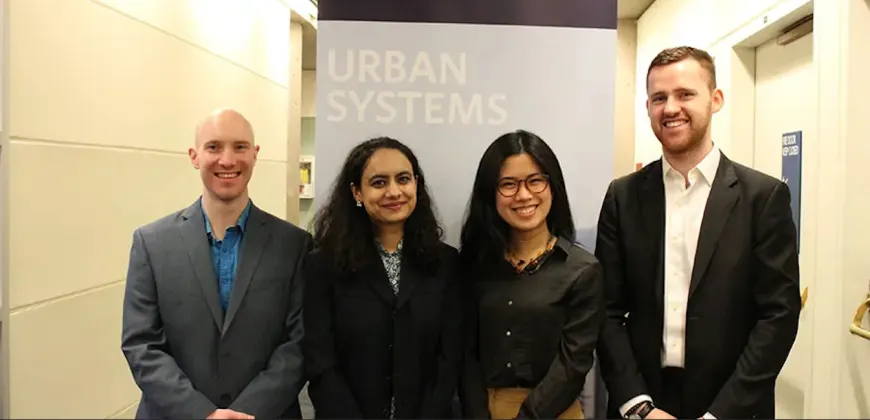Shining a light on asset management
Three students in the MEL in Urban Systems developed a streetlight asset management plan for the City of Surrey. With its assessment of the current state of the infrastructure and seven key recommendations, the plan can now be considered by the City to help meet the goals in its Sustainability Charter.

A city’s infrastructure – roads, transportation networks, and water and energy distribution systems –represent a significant investment. Managing these assets over their life cycle is critical to ensuring they continue to meet a municipality’s evolving social, economic and environmental needs.
Students in the MEL in Urban Systems develop their knowledge of asset management through a course that culminates in the completion of an asset management plan for a local municipality.
“There’s a whole life cycle to be considered with urban infrastructure, from planning and design to project delivery and operationalization,” says Cexiang Foo, a student in the 2021 cohort. “Asset management is a critical part of that because urban systems have such long life cycles, making it very important to maximize the value of those assets.”
The Infrastructure Asset Management course introduces students to a range of considerations, from condition assessment and performance prediction to multi-criteria decision-making and life-cycle cost analysis. The final project requires students to develop an asset management plan for an infrastructure system of their choosing.
Cexiang, along with students Peter Sun and Cici Chen, decided to focus on streetlights. “As pedestrians, cyclists and motorists in an urban environment, we all experience streetlights on a daily basis in the city and have a sense of their impact on our safety,” says Peter.
“Streetlights also interested us because municipalities are transitioning from high pressure sodium to LED to reduce energy consumption. We were interested in this area for its intersection of citizen quality of life and sustainability issues.”
One of the industry advisory board members for the Urban Systems program connected the students to the City of Surrey, which is currently replacing its high pressure sodium streetlights with LED options. The largest city by land area in Metro Vancouver, Surrey has over 28,000 lighting fixtures. The students obtained reports and data sets from two contacts at the City and created an asset management plan that could provide Surrey with a framework for better managing its lighting infrastructure.
As the students note in their report, LED fixtures offer numerous benefits over high pressure sodium lights, with LED bulbs generally needing to be replaced every 20 years (rather than every five) and having a longer required time between cleanings.
Once Surrey replaces all of its fixtures, the municipality could see maintenance savings of $700,000 annually. Energy consumption is also expected to decrease by 30% and the bulbs are easier to recycle than high pressure sodium bulbs.
Cexiang, Cici and Peter began with a review of the existing infrastructure, examining data on location, value, condition, remaining service life, level of service required for each fixture, associated risks, and priority for replacement and repair for the streetlights.
Surrey currently uses a four-point system to assess the physical condition of streetlights on a five-year schedule. The students noted that this approach does not provide the City with comprehensive information as 98% of the assets are rated as being in excellent condition.
“Having almost all the infrastructure in one category makes it hard to differentiate between actual asset conditions,” says Cici. “We recommended moving from the four-point grading scale to a five-point rating that is aligned with the grading scheme in the Canadian Infrastructure Report Card.”
This approach would consider both physical condition (rust, peeling paint, LED diode) and function (whether the asset is meeting energy efficiency and lighting illuminance goals). As their Asset Management Plan summarizes: “The current physical condition rating system does not provide an accurate indicator for long-term financial and maintenance planning.”
The group proposed a list of performance measures for levels of service in the categories of reliability, safety, sustainability and cost-effectiveness.
They also proposed new service level indicators to improve the average response time for pole failures and streetlight outages from 10 days to two.
“Risk management is an important area in our asset management plan,” says Peter. “The City had identified potential risks of poles toppling over or bulbs going out, but as part of our assessment we explored additional different scenarios and used methodology from InfraGuide Canada to assess risk factors including natural disasters, traffic accidents, vandalism, asset deterioration or failure, and operational risk.”
The group then developed a matrix based on their comprehensive risk analysis and proposed strategies for each identified risk.
Given that the ultimate goal of an asset management plan is to optimize the life-cycle costs of an asset, the students proposed two initiatives for the City to consider.
The first was a new LED lighting rollout that prioritizes areas that offer the greatest safety benefits.
These are areas where existing streetlight coverage does not meet required levels of service and major roads with high traffic volumes.
The second strategy to maximize the value of the asset is to integrate smart technology. “This would allow the lights to be monitored for energy usage and remotely adjusted for energy savings, provide automatic notifications if there’s an outage or enable for remote control of light direction and intensity,” says Cexiang.
Asset management was a new field for Peter, Cici and Cexiang, who have backgrounds in architecture (Peter) and urban planning (Cici and Cexiang). “None of us had experience in asset management or streetlights before this project,” says Cici.
“We’re doing the MEL in Urban Systems and we chose this specific topic because we want to stretch our knowledge in new areas and learn new skills.”
Having learned the principles and methodology behind asset management and put these into practice by developing the Surrey lighting plan, the three are now looking forward to opportunities to apply these new skills in their future professional work.



